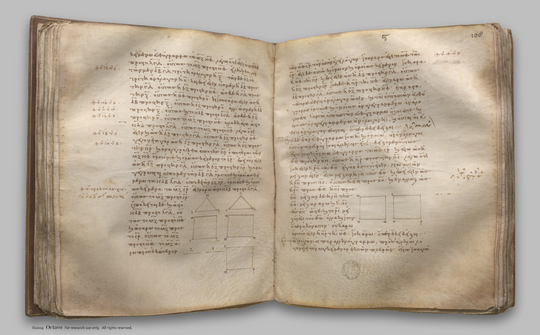index prev next | digilib folio 112

Equiangular parallelograms have to one another the ratio compounded of the ratios of their sides.
| Τὰ ἰσογώνια παραλληλόγραμμα πρὸς ἄλληλα λόγον ἔχει τὸν συγκείμενον ἐκ τῶν πλευρῶν. Ἔστω ἰσογώνια παραλληλόγραμμα τὰ ΑΓ, ΓΖ ἴσην ἔχοντα τὴν ὑπὸ ΒΓΔ γωνίαν τῇ ὑπὸ ΕΓΗ: λέγω, ὅτι τὸ ΑΓ παραλληλόγραμμον πρὸς τὸ ΓΖ παραλληλόγραμμον λόγον ἔχει τὸν συγκείμενον ἐκ τῶν πλευρῶν. Κείσθω γὰρ ὥστε ἐπ' εὐθείας εἶναι τὴν ΒΓ τῇ ΓΗ: ἐπ' εὐθείας ἄρα ἐστὶ καὶ ἡ ΔΓ τῇ ΓΕ. καὶ συμπεπληρώσθω τὸ ΔΗ παραλληλόγραμμον, καὶ ἐκκείσθω τις εὐθεῖα ἡ Κ, καὶ γεγονέτω ὡς μὲν ἡ ΒΓ πρὸς τὴν ΓΗ, οὕτως ἡ Κ πρὸς τὴν Λ, ὡς δὲ ἡ ΔΓ πρὸς τὴν ΓΕ, οὕτως ἡ Λ πρὸς τὴν Μ. Οἱ ἄρα λόγοι τῆς τε Κ πρὸς τὴν Λ καὶ τῆς Λ πρὸς τὴν Μ οἱ αὐτοί εἰσι τοῖς λόγοις τῶν πλευρῶν, τῆς τε ΒΓ πρὸς τὴν ΓΗ καὶ τῆς ΔΓ πρὸς τὴν ΓΕ. ἀλλ' ὁ τῆς Κ πρὸς Μ λόγος σύγκειται ἔκ τε τοῦ τῆς Κ πρὸς Λ λόγου καὶ τοῦ τῆς Λ πρὸς Μ: ὥστε καὶ ἡ Κ πρὸς τὴν Μ λόγον ἔχει τὸν συγκείμενον ἐκ τῶν πλευρῶν. καὶ ἐπεί ἐστιν ὡς ἡ ΒΓ πρὸς τὴν ΓΗ, οὕτως τὸ ΑΓ παραλληλόγραμμον πρὸς τὸ ΓΘ, ἀλλ' ὡς ἡ ΒΓ πρὸς τὴν ΓΗ, οὕτως ἡ Κ πρὸς τὴν Λ, καὶ ὡς ἄρα ἡ Κ πρὸς τὴν Λ, οὕτως τὸ ΑΓ πρὸς τὸ ΓΘ. πάλιν, ἐπεί ἐστιν ὡς ἡ ΔΓ πρὸς τὴν ΓΕ, οὕτως τὸ ΓΘ παραλληλόγραμμον πρὸς τὸ ΓΖ, ἀλλ' ὡς ἡ ΔΓ πρὸς τὴν ΓΕ, οὕτως ἡ Λ πρὸς τὴν Μ, καὶ ὡς ἄρα ἡ Λ πρὸς τὴν Μ, οὕτως τὸ ΓΘ παραλληλόγραμμον πρὸς τὸ ΓΖ παραλληλόγραμμον. ἐπεὶ οὖν ἐδείχθη, ὡς μὲν ἡ Κ πρὸς τὴν Λ, οὕτως τὸ ΑΓ παραλληλόγραμμον πρὸς τὸ ΓΘ παραλληλόγραμμον, ὡς δὲ ἡ Λ πρὸς τὴν Μ, οὕτως τὸ ΓΘ παραλληλόγραμμον πρὸς τὸ ΓΖ παραλληλόγραμμον, δι' ἴσου ἄρα ἐστὶν ὡς ἡ Κ πρὸς τὴν Μ, οὕτως τὸ ΑΓ πρὸς τὸ ΓΖ παραλληλόγραμμον. ἡ δὲ Κ πρὸς τὴν Μ λόγον ἔχει τὸν συγκείμενον ἐκ τῶν πλευρῶν: καὶ τὸ ΑΓ ἄρα πρὸς τὸ ΓΖ λόγον ἔχει τὸν συγκείμενον ἐκ τῶν πλευρῶν. Τὰ ἄρα ἰσογώνια παραλληλόγραμμα πρὸς ἄλληλα λόγον ἔχει τὸν συγκείμενον ἐκ τῶν πλευρῶν: ὅπερ ἔδει δεῖξαι. | Equiangular parallelograms have to one another the ratio compounded of the ratios of their sides. Let AC, CF be equiangular parallelograms having the angle BCD equal to the angle ECG; I say that the parallelogram AC has to the parallelogram CF the ratio compounded of the ratios of the sides. For let them be placed so that BC is in a straight line with CG; therefore DC is also in a straight line with CE. Let the parallelogram DG be completed; let a straight line K be set out, and let it be contrived that, as BC is to CG, so is K to L, and, as DC is to CE, so is L to M. [VI. 12] Then the ratios of K to L and of L to M are the same as the ratios of the sides, namely of BC to CG and of DC to CE. But the ratio of K to M is compounded of the ratio of K to L and of that of L to M; so that K has also to M the ratio compounded of the ratios of the sides. Now since, as BC is to CG, so is the parallelogram AC to the parallelogram CH, [VI. 1] while, as BC is to CG, so is K to L, therefore also, as K is to L, so is AC to CH. [V. 11] Again, since, as DC is to CE, so is the parallelogram CH to CF, [VI. 1] while, as DC is to CE, so is L to M, therefore also, as L is to M, so is the parallelogram CH to the parallelogram CF. [V. 11] Since then it was proved that, as K is to L, so is the parallelogram AC to the parallelogram CH, and, as L is to M, so is the parallelogram CH to the parallelogram CF, therefore, ex aequali, as K is to M, so is AC to the parallelogram CF. But K has to M the ratio compounded of the ratios of the sides; therefore AC also has to CF the ratio compounded of the ratios of the sides. |